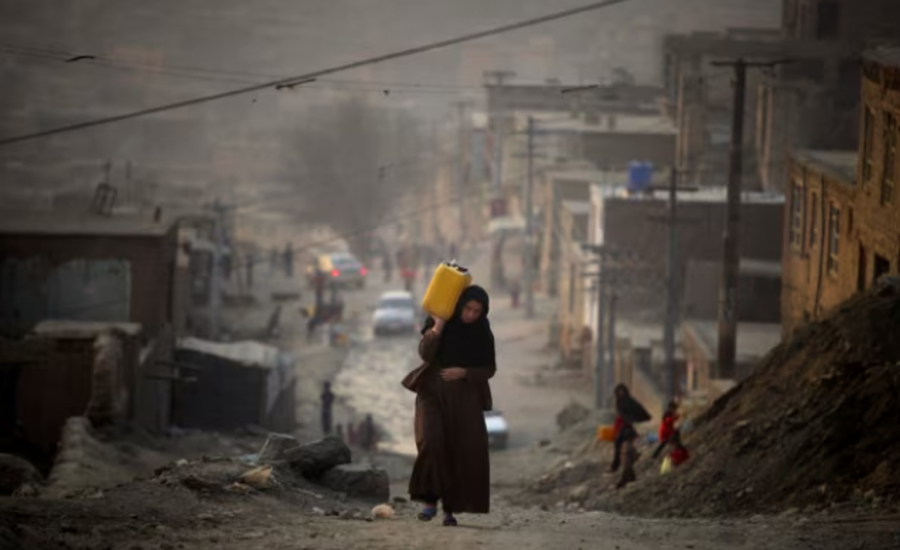
Kabul could become the first capital in the world to run out of water, experts have said, citing several factors that have worsened the situation, including rapid population growth, climate change and mismanagement.
The Afghan capital's groundwater levels have dropped by nearly 30 meters over the past decade, while almost half of the city's wells - the main source of drinking water for residents - are now dry, according to a recent study by the non-governmental organization, Mercy Crops.
The demand for groundwater in the city is disproportionately high: each year, 44 million cubic meters more water is extracted than can be replenished.
Kabul's population has grown from nearly 2 million in 2000 to more than 6 million in 2025, further straining water supplies, which could run out within five years.
Even groundwater reserves have begun to dry up due to over 100,000 unregulated wells and hundreds of factories and greenhouses, according to experts from the Mercy Corps organization and water management experts, whom Radio Free Europe/Radio Liberty spoke with.
"Kabul has more than 400 hectares of greenhouses that consume about 4 million cubic meters of water per year," said Najibullah Sadid, a researcher on water resources and climate change based in Germany.
"There are more than 500 beverage businesses operating in Kabul. Of these, Alokozay, the largest beverage company in the city, uses about 1 million cubic meters of groundwater every year."
The United Nations has warned that without urgent action, Kabul's groundwater could be completely depleted by 2030, posing an existential threat to residents and risking a massive wave of migration.
'Choosing between water and food'
Many areas of Kabul have already dried up and residents are completely dependent on the limited amount of water they buy from tankers.
A person living in the relatively affluent Taumani area, northwest of Kabul, said he spends a quarter of his salary on buying water.
"My monthly salary is $300 and I spend $70 on water for our family of 10," he told Radio Free Europe on July 26.
"We use this water for tea, cooking, washing clothes and hygiene."
"There are many families who cannot afford to buy water and it is like choosing between water and food," said this Taiman resident.
He said those who cannot afford to buy water travel dozens of kilometers to get it from other areas. Many apartment blocks in Kabul only have water once or twice a week.
Water pollution is another challenge that has affected Afghanistan, where 80 percent of the population does not have access to safe drinking water, according to United Nations data.
A large amount of groundwater in Kabul is contaminated with sewage, toxins, and high levels of arsenic.
Potential solutions
According to the World Bank, Afghanistan's previous Western-backed government – which was overthrown in 2021 – received more than $4 billion from international donors to reform the water sector, but it remains underdeveloped in both the capital and the rest of the country.
Officials from the current government in Kabul - which is led by the Taliban - did not respond to RFE/RL's request for comment. However, many local experts believe that the Afghan capital still has a chance to resolve its water crisis relatively quickly if decisive steps are taken.
"This problem is not new. For more than a decade, ideas have been presented to Afghan authorities on how to solve this problem, but it has never been a priority," Sadid told Radio Free Europe.
Among the ideas has been the construction of the Shahtoot Dam and reservoir, about 30 kilometers southwest of Kabul. If completed, the system could provide water to the city's more than 2 million residents and avoid side problems.
Another project envisages the construction of a 200-kilometer pipeline to divert more than 100 million cubic meters of water per year from the Panjshir River, which runs through the capital.
The previous government also conducted feasibility studies for both of these projects.
In April, the Taliban Ministry of Energy and Water said it was awaiting budget approval to begin work on the construction of the pipeline on the Panjshir River.
There are reports that authorities are looking for investors for this initiative, which is believed to cost $170 million.
Meanwhile, the Shahtoot project is expected to be completed in 2027, if Afghanistan manages to secure the funds.
It is estimated that the entire project will cost about $236 million to complete the dam and reservoir.
Abdul Baset Rahmani, a Kabul-based expert on water resources and climate change, said that the water shortage in the Afghan capital "can be solved within a year and a half, if there is political will."
However, he warned of urgent needs in the short term, calling on international aid agencies "to provide urgent assistance to poor people in Kabul who cannot afford to buy drinking water."
"Such support would relieve many people from great financial and mental hardship, prevent diseases, and help many people return to school," he said.
"There are many children who cannot access education because they have to walk for kilometers to help their families get supplies in areas where there is free drinking water."
Aid groups, such as the International Committee of the Red Cross and the United Nations Children's Agency (UNICEF), have carried out several projects in Afghanistan in recent years to help thousands of people access drinking water.
According to the Red Cross, their projects in 2024 include repairing "1,315 hand pumps and installing 1,888 sand filters to remove pollutants from water" in several Afghan provinces.
Despite these efforts, unless the government takes urgent steps, or major infrastructure projects are completed, Kabul's water crisis is expected to continue and could force around three million residents - or half of Kabul's population - to flee the city./ REL (A2 Televizion)











